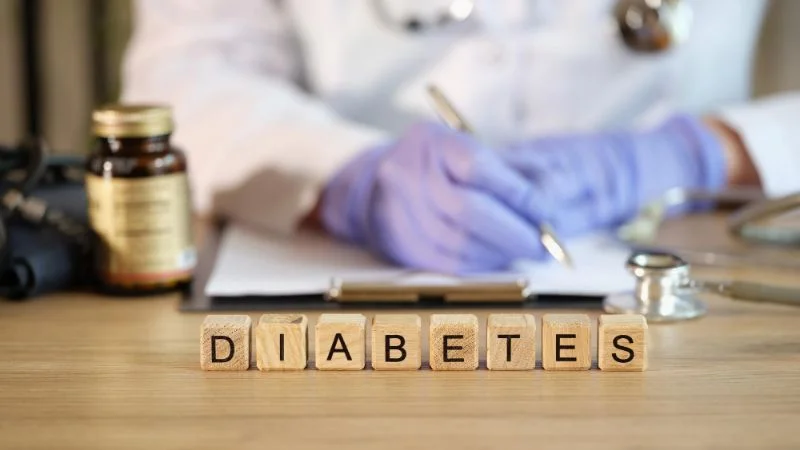Diabetes mellitus is a chronic medical condition that affects millions of people worldwide. There are two primary types of diabetes mellitus: Type 1 and Type 2. While both types share some similarities, they are distinct in terms of their causes, symptoms, and treatment approaches. Understanding the differences between Type 1 and Type 2 diabetes is essential for effectively managing the condition. This blog post will delve deeper into Type 1 vs. Type 2 diabetes mellitus, exploring their unique features, risk factors, symptoms, and treatment options. By the end of this article, you'll have a comprehensive understanding of these two diabetes types and be better equipped to make informed decisions regarding your health.
The Basics: What Is Type 1 Diabetes?
Type 1 diabetes, also known as juvenile diabetes, is a chronic condition that occurs when the pancreas is unable to produce enough insulin, a hormone that regulates blood sugar levels. This condition is usually diagnosed in children and young adults, although it can develop at any age. Type 1 diabetes is characterized by an autoimmune response, where the body's immune system mistakenly attacks and destroys the insulin-producing cells in the pancreas, resulting in an absolute insulin deficiency. Genetic factors may play a role in developing Type 1 diabetes, and certain environmental triggers, such as viruses, may also contribute to the condition. Type 1 diabetes is not preventable, and there is no cure for this condition. People with Type 1 diabetes require insulin injections or an insulin pump to manage their blood sugar levels effectively.
The Basics: What Is Type 2 Diabetes?
Type 2 diabetes is the most common type of diabetes, accounting for about 90% of all cases. This condition occurs when the body becomes resistant to insulin or does not produce enough insulin to regulate blood sugar levels effectively. Type 2 diabetes typically develops in adults over 45 but can also occur in younger people. The primary risk factors for Type 2 diabetes include obesity, a sedentary lifestyle, family history of diabetes, and ethnicity. While genetic factors can influence insulin resistance and the ability of the pancreas to produce insulin, lifestyle choices, such as an unhealthy diet and lack of physical activity, significantly contribute to its development. Type 2 diabetes can often be managed with lifestyle changes, such as a healthy diet, regular exercise, weight loss, and stress management. In some cases, medications may be prescribed to manage blood sugar levels.

Causes and Risk Factors of Type 1 Diabetes
The exact cause of Type 1 diabetes is unknown, but it is believed to be an autoimmune disorder. In Type 1 diabetes, the body's immune system mistakenly attacks and destroys the insulin-producing cells in the pancreas. Genetic factors are thought to play a role in developing Type 1 diabetes, as certain genes may increase the risk of developing the condition. However, not everyone with these genetic factors develops diabetes, indicating that other factors, such as environmental triggers, are also involved. Some potential environmental triggers include viral infections, exposure to certain chemicals, and early childhood diet and nutrition. Type 1 diabetes is not preventable, and there is no cure for this condition.
Causes and Risk Factors of Type 2 Diabetes
A combination of genetic and lifestyle factors causes type 2 diabetes. People with a family history of diabetes are at a higher risk of developing the condition, as certain genes can influence insulin resistance and the ability of the pancreas to produce insulin. However, lifestyle choices play a significant role in developing Type 2 diabetes. Being overweight or obese increases the risk of insulin resistance, as excess body fat can interfere with the body's ability to use insulin effectively. A sedentary lifestyle and lack of physical activity also contribute to insulin resistance. Ethnicity is another risk factor, with individuals of Hispanic, African American, Asian, Pacific Islander, or Native American descent at a higher risk of developing Type 2 diabetes. Age is also a factor, as the risk increases with age, especially after 45 years old. A history of gestational diabetes during pregnancy can also increase the risk. Not everyone with these risk factors will develop Type 2 diabetes, and individuals without these risk factors can still develop the condition. Fortunately, Type 2 diabetes can often be prevented or delayed through lifestyle changes, such as maintaining a healthy weight, adopting a balanced diet, engaging in regular physical activity, and managing stress.
Symptoms of Type 1 Diabetes
The symptoms of Type 1 diabetes can develop quickly and are often more severe than those of Type 2 diabetes. Common symptoms include:
Frequent urination: The kidneys work to remove excess sugar from the blood, leading to increased urine production.
Excessive thirst: Frequent urination can cause dehydration, leading to increased thirst.
Unexplained weight loss: Without sufficient insulin, the body is unable to properly utilize glucose as an energy source, resulting in weight loss.
Fatigue and weakness: Inadequate glucose uptake by cells can lead to a lack of energy and fatigue.
Increased hunger: The body's cells may not receive enough glucose, leading to persistent hunger.
Blurred vision: High blood sugar levels can cause fluid to be pulled from the lenses of the eyes, resulting in blurred vision.
Irritability and mood changes: Fluctuations in blood sugar levels can affect mood and cause irritability.
Yeast infections: High blood sugar levels create an environment conducive to yeast growth, leading to frequent infections.
Symptoms of Type 2 Diabetes
The symptoms of Type 2 diabetes may develop gradually, and some people may not experience noticeable symptoms initially. Common symptoms include:
Increased thirst: The body tries to compensate for elevated blood sugar levels by causing thirst.
Frequent urination: Excess glucose in the bloodstream leads to increased urine production.
Fatigue: Inadequate glucose uptake by cells can result in fatigue and lack of energy.
Blurred vision: High blood sugar levels can cause fluid to be pulled from the lenses of the eyes, resulting in blurred vision.
Slow-healing wounds: Elevated blood sugar levels can impair the body's ability to heal wounds effectively.
Recurrent infections: Yeast infections, urinary tract infections, and skin infections may be more common due to elevated blood sugar levels.
Tingling or numbness: Prolonged high blood sugar levels can damage the nerves, leading to tingling or numbness in the hands and feet.
Erectile dysfunction: Men with Type 2 diabetes may experience difficulties with achieving or maintaining an erection.
Diagnosis of Type 1 Diabetes
Type 1 diabetes is typically diagnosed through a combination of symptoms, blood tests, and medical history. The following tests may be conducted:
Fasting blood glucose test: A blood sample is taken after an overnight fast to measure the blood sugar levels. A diagnosis of diabetes is made if the fasting blood glucose level is equal to or greater than 126 milligrams per deciliter (mg/dL) on two separate occasions.
Random blood glucose test: This test involves measuring blood sugar levels at any time of the day, regardless of the last meal.
Oral glucose tolerance test (OGTT): After an overnight fast, a person drinks a sugary liquid, and blood sugar levels are measured at regular intervals.
Glycated Hemoglobin (HbA1C) Test: This blood test provides an average of blood sugar levels over the past two to three months. An HbA1C level of 6.5% or higher on two separate tests indicates diabetes.
Urine Analysis: A urine sample may be tested to check for the presence of glucose and ketones. High levels of glucose and ketones in the urine can suggest diabetes.
C-Peptide Test: This blood test measures the level of C-peptide, a byproduct of insulin production. Low levels of C-peptide and high blood sugar can indicate Type 1 diabetes.
Autoantibodies: The detection of autoantibodies is an important marker of an autoimmune response, helping to differentiate Type 1 diabetes from other forms of diabetes, such as Type 2 diabetes. The most common autoantibodies associated with Type 1 diabetes include islet cell antibodies (ICA), glutamic acid decarboxylase antibodies (GADA), and insulin autoantibodies (IAA), among others. The antibody test measures the levels of these autoantibodies in the blood.
It's important to consult with a healthcare professional for an accurate diagnosis and to develop an appropriate treatment plan based on the test results and individual circumstances.
Diagnosis of Type 2 Diabetes
The diagnosis of Type 2 diabetes involves similar tests to those used for Type 1 diabetes. These tests include:
Fasting blood glucose test: A blood sample is taken after an overnight fast to measure blood sugar levels.
Random blood glucose test: Blood sugar levels are measured at any time of the day, regardless of the last meal.
Oral glucose tolerance test (OGTT): After an overnight fast, a person drinks a sugary liquid, and blood sugar levels are measured at regular intervals.
HbA1c test: HbA1c levels may be measured to assess long-term glucose control.
It's important to note that the diagnostic criteria and tests may vary slightly depending on the guidelines and recommendations of different medical organizations.
Management and Treatment of Type 1 Diabetes
In Type 1 diabetes, the body does not produce insulin, requiring lifelong insulin therapy. The treatment goals for Type 1 diabetes include achieving stable blood sugar levels within the target range, preventing hypoglycemia (low blood sugar), and minimizing the risk of diabetic ketoacidosis (DKA). Along with insulin injections or insulin pump therapy, individuals with Type 1 diabetes may need to monitor their blood sugar levels frequently, count carbohydrates, and adjust their insulin doses accordingly. Type 1 diabetes is managed through a combination of insulin therapy, blood sugar monitoring, healthy eating, regular physical activity, and support from healthcare professionals. Treatment options include:
Insulin therapy: Since the pancreas does not produce sufficient insulin, people with Type 1 diabetes require insulin injections or the use of an insulin pump to regulate blood sugar levels.
Blood sugar monitoring: Regular blood sugar monitoring and frequent follow-ups with healthcare providers are essential for adjusting insulin doses and maintaining optimal blood sugar control.
Healthy eating: A balanced diet that focuses on whole foods, including fruits, vegetables, lean proteins, and whole grains, is important for maintaining stable blood sugar levels.
Regular physical activity: Engaging in regular exercise or physical activity helps improve insulin sensitivity and promotes overall health.
Diabetes education and support: Learning about diabetes management and having access to support from healthcare professionals, diabetes educators, and support groups can be beneficial.
Management and Treatment of Type 2 Diabetes
Type 2 diabetes is often initially managed through lifestyle modifications. These modifications may include adopting a healthy diet, engaging in regular physical activity, losing weight if necessary, and quitting smoking. The treatment goals for Type 2 diabetes focus on achieving and maintaining a healthy blood sugar level, managing blood pressure and cholesterol levels, and reducing the risk of complications. Medications, such as oral antidiabetic drugs or injectable medications, may be prescribed if lifestyle changes alone are insufficient to control blood sugar levels. Treatment options include:
Healthy eating: Following a well-balanced diet that emphasizes fruits, vegetables, whole grains, lean proteins, and healthy fats can help control blood sugar levels.
Regular physical activity: Engaging in moderate-intensity aerobic exercise, such as brisk walking or cycling, for at least 150 minutes per week is recommended.
Weight management: Losing weight, if overweight or obese, can improve insulin sensitivity and blood sugar control.
Medications: In some cases, oral medications or injectable medications, such as insulin or other glucose-lowering medications, may be prescribed to help manage blood sugar levels effectively.
Regular check-ups and monitoring: Regular visits to healthcare professionals are important for monitoring blood sugar levels, assessing the effectiveness of treatment, and making any necessary adjustments.
It's important to work with your healthcare provider to establish personalized treatment goals and develop a comprehensive treatment plan that suits your individual needs.

Potential Complications: Type 1 and Type 2 Diabetes
Diabetes, if not properly managed, can lead to various long-term complications that affect different parts of the body. It's important to be aware of these complications and take steps to prevent or manage them effectively. Some common long-term complications of diabetes include:
Cardiovascular disease: Diabetes increases the risk of heart disease, heart attacks, and strokes. Managing blood pressure, cholesterol levels, and blood sugar levels is crucial in reducing this risk. Regular exercise, a healthy diet, and medication, if necessary, can help maintain a healthy cardiovascular system.
Kidney disease: Diabetes can damage the kidneys over time, leading to diabetic nephropathy. Monitoring kidney function through regular urine and blood tests, controlling blood sugar levels, and managing blood pressure is essential in preventing or slowing the progression of kidney disease.
Neuropathy: High blood sugar levels can damage the nerves, causing neuropathy. This condition can result in numbness, tingling, pain, or weakness in the affected areas, commonly in the feet and legs. Good blood sugar control, regular foot care, and medications for symptom management are vital in preventing complications associated with neuropathy.
Retinopathy: Diabetes can damage the blood vessels in the retina, leading to diabetic retinopathy, a common cause of vision loss and blindness. Regular eye exams, blood sugar control, blood pressure management, and timely treatment, such as laser therapy or injections, can help preserve vision.
Foot problems: Diabetes can cause poor circulation and nerve damage in the feet, making them susceptible to infections and slow healing of wounds. Proper foot care, regular examinations, wearing appropriate footwear, and managing blood sugar levels are crucial in preventing foot complications.
Skin conditions: People with diabetes are more prone to skin conditions, including dry skin, fungal infections, and bacterial infections. Maintaining good blood sugar control, practicing good hygiene, and promptly treating any skin issues can help prevent complications.
It's important to work closely with your healthcare team to monitor for these complications and take necessary preventive measures. Regular check-ups and open communication with your healthcare provider are key to managing diabetes effectively.
Lifestyle Modifications: Type 1 and Type 2 Diabetes
Adopting a healthy lifestyle is crucial to managing both Type 1 and Type 2 diabetes. Here are some practical tips for making positive lifestyle changes:
Balanced Diet: Focus on a well-balanced diet that includes a variety of nutrient-rich foods such as fruits, vegetables, whole grains, lean proteins, and healthy fats. Limit the intake of processed foods, sugary beverages, and foods high in saturated and trans fats. Consider consulting a registered dietitian for personalized meal planning and guidance.
Regular Physical Activity: Engage in regular exercise as advised by your healthcare provider. Aim for a combination of aerobic activities (such as brisk walking, cycling, or swimming) and strength training exercises. Start gradually and gradually increase the duration and intensity of your workouts. Be consistent with physical activity to improve blood sugar control, enhance cardiovascular health, and maintain a healthy weight.
Blood Sugar Monitoring: Monitor blood sugar levels regularly as your healthcare provider advises. Keep a record of your readings to identify patterns and make necessary adjustments in your treatment plan. Self-monitoring of blood glucose (SMBG) involves using a glucometer to measure blood sugar levels at home. Keeping a record of your readings can provide valuable insights for you and your healthcare team.
Medication and Insulin Management: Follow your healthcare provider's instructions carefully if prescribed medication or insulin. Taking your prescribed medications as directed by your healthcare provider is crucial in maintaining stable blood sugar levels. It's important to follow the recommended dosage, frequency, and timing of medications. If you have any concerns or experience side effects, consult your healthcare provider before making any changes. Seek guidance from your healthcare provider or diabetes educator if you have any questions or concerns about medication or insulin management.
Stress Management: Find healthy ways to manage stress, as it can affect blood sugar levels. Engage in activities that help you relax, such as meditation, deep breathing exercises, yoga, or hobbies you enjoy. Adequate sleep, social support, and a healthy work-life balance are also essential in managing stress.
Regular Check-ups: Schedule regular check-ups with your healthcare provider to monitor your diabetes management progress and address any concerns or questions. These appointments will also include assessments of blood pressure, cholesterol levels, kidney function, and other health parameters related to diabetes management.
Carbohydrate counting: One effective strategy for managing blood sugar levels in diabetes is carbohydrate counting and meal planning. Carbohydrate counting involves monitoring and tracking the number of carbohydrates consumed in meals and snacks. Since carbohydrates have the most significant impact on blood sugar levels, understanding and controlling carbohydrate intake can help individuals with diabetes maintain stable blood sugar levels throughout the day. Meal planning plays a vital role in carbohydrate counting. It involves selecting appropriate foods, portion sizes, and timing of meals to achieve a balanced and individualized diet. By working with a registered dietitian or certified diabetes educator, you can learn how to identify and measure carbohydrates in different food groups, read nutrition labels, and create meal plans that align with your specific carbohydrate and calorie targets. Remember that individual carbohydrate goals may vary based on factors such as medication, physical activity levels, and personal preferences. Regular blood sugar monitoring and adjustments in insulin or medication doses may be necessary when practicing carbohydrate counting.
Remember that lifestyle changes take time and consistency to yield positive results. Gradually incorporate these tips into your daily routine and seek support from healthcare professionals, diabetes educators, or support groups to stay motivated and make sustainable changes.
Research and Advances: Type 1 and Type 2 Diabetes
The field of diabetes treatment is continuously evolving, with ongoing research and emerging therapies offering new possibilities for improved management. Here are some noteworthy advancements to keep an eye on:
Closed-Loop Insulin Delivery Systems (Artificial Pancreas): Closed-loop systems, also known as artificial pancreas systems, combine continuous glucose monitoring (CGM) devices with insulin pumps to automate insulin delivery based on real-time glucose levels. These systems help maintain optimal blood sugar control and reduce the burden of constant monitoring and manual insulin administration.
Glucose Monitoring Technologies: Continuous glucose monitoring (CGM) devices have undergone significant advancements, offering improved accuracy, convenience, and features such as smartphone connectivity and predictive algorithms. Some CGM systems offer real-time glucose readings, trend data, and alerts for high and low blood sugar levels. Additionally, flash glucose monitoring (FGM) systems provide on-demand glucose readings by scanning a sensor with a reader or smartphone. These devices allow for real-time tracking of blood sugar levels and help individuals make informed decisions regarding insulin dosing and lifestyle choices.
Insulin Delivery Options: Besides traditional insulin injections, alternative methods of insulin delivery are emerging. Inhalable insulin and oral insulin formulations are being developed as convenient alternatives for some individuals with diabetes. These options aim to enhance insulin delivery comfort and convenience, although they may not be suitable for everyone.
Gene Therapy and Immunotherapy: Research into gene therapy and immunotherapy approaches for Type 1 diabetes is ongoing. These innovative treatments aim to restore or protect insulin-producing beta cells in the pancreas, potentially offering a more targeted and long-lasting solution for managing Type 1 diabetes.
Precision Medicine: The concept of precision medicine involves tailoring diabetes treatment approaches based on an individual's genetic makeup, lifestyle factors, and specific needs. This approach aims to optimize treatment outcomes by providing personalized and targeted therapies.
Glucose-sensing contact lenses: Researchers are exploring the development of contact lenses embedded with glucose sensors. These lenses can continuously monitor blood sugar levels in tears, providing a non-invasive and convenient method for diabetes management.
Targeted therapies: Researchers are investigating targeted therapies aimed at addressing the underlying causes of diabetes. This includes developing medications that can preserve or regenerate pancreatic beta cells, improve insulin sensitivity, or modulate the immune response associated with Type 1 diabetes.
Behavioral interventions: Studies have highlighted the importance of behavioral interventions, such as cognitive-behavioral therapy (CBT), in diabetes management. CBT can help individuals address emotional and psychological factors that may impact their self-care practices, improve medication adherence, and enhance overall well-being.
Telemedicine and digital health solutions: The integration of telemedicine and digital health solutions has transformed diabetes management. Remote consultations, mobile applications, and virtual coaching programs provide convenient access to healthcare professionals, personalized education, and real-time support.
Keeping up with the latest research and advancements in diabetes management can help you stay informed about potential future developments and treatment options. Consult with your healthcare provider to discuss any emerging therapies or technologies that may be relevant to your diabetes management.
Living with Type 1 or Type 2 Diabetes
Living with diabetes can be challenging, but resources and support are available. Diabetes support groups, educational programs, and online communities can provide valuable information, emotional support, and practical tips for managing diabetes effectively. Healthcare providers, including endocrinologists, diabetes educators, and registered dietitians, can offer personalized support and treatment plans to help individuals with diabetes navigate their condition. Establishing a strong support network and maintaining regular communication with healthcare providers is essential to ensure optimal diabetes care.
Conclusion
In conclusion, understanding the differences between Type 1 and Type 2 diabetes is essential for managing the condition effectively. While both types share some similarities, their causes, symptoms, and treatment differ. Lifestyle changes, medication, and insulin therapy are important factors in managing both types of diabetes, and regular blood sugar monitoring is essential for reducing the risk of complications. Cura4U is a one-stop-healthcare platform that offers patients in the USA access to lab, radiology, and doctor's appointment services online from within the Cura4U portal and mobile app. Our platform assists patients in receiving the Right Care at the Right Price. Schedule your appointments online and get the best healthcare services at your doorstep.
Our clinical experts continually monitor the health and medical content posted on CURA4U, and we update our blogs and articles when new information becomes available. Last reviewed by Dr. Tayyab Saeed Akhter on June 16th, 2023.
References
What is diabetes? | CDC- https://www.cdc.gov/diabetes/basics/diabetes.html
Symptoms & Causes of Diabetes - NIDDK (nih.gov)- https://www.niddk.nih.gov/health-information/diabetes/overview/symptoms-causes
Diabetes Symptoms, Causes, & Treatment | ADA- https://diabetes.org/diabetes
Type 1 diabetes - Symptoms and causes - Mayo Clinic- https://www.mayoclinic.org/diseases-conditions/type-1-diabetes/symptoms-causes/syc-20353011
Diabetes (who.int)- https://www.who.int/news-room/fact-sheets/detail/diabetes
Type 2 diabetes - Symptoms and causes - Mayo Clinic- https://www.mayoclinic.org/diseases-conditions/type-2-diabetes/symptoms-causes/syc-20351193
Type 2 Diabetes Mellitus: Practice Essentials, Background, Pathophysiology (medscape.com)- https://emedicine.medscape.com/article/117853-overview
Insulin Resistance, Type 1 and Type 2 Diabetes, and Related Complications 2017 - PMC (nih.gov)- https://www.ncbi.nlm.nih.gov/pmc/articles/PMC5723935/
Type 2 Diabetes Mellitus: A Review of Current Trends - PMC (nih.gov)- https://www.ncbi.nlm.nih.gov/pmc/articles/PMC3464757/
Type 1 and Type 2 Diabetes | Diabetes | American Diabetes Association (diabetesjournals.org)- https://diabetesjournals.org/diabetes/article/54/suppl_2/S40/12845/Type-1-and-Type-2-DiabetesWhat-Do-They-Have-in
Patient education: Type 2 diabetes: Overview (Beyond the Basics) - UpToDate- https://www.uptodate.com/contents/type-2-diabetes-overview-beyond-the-basics












